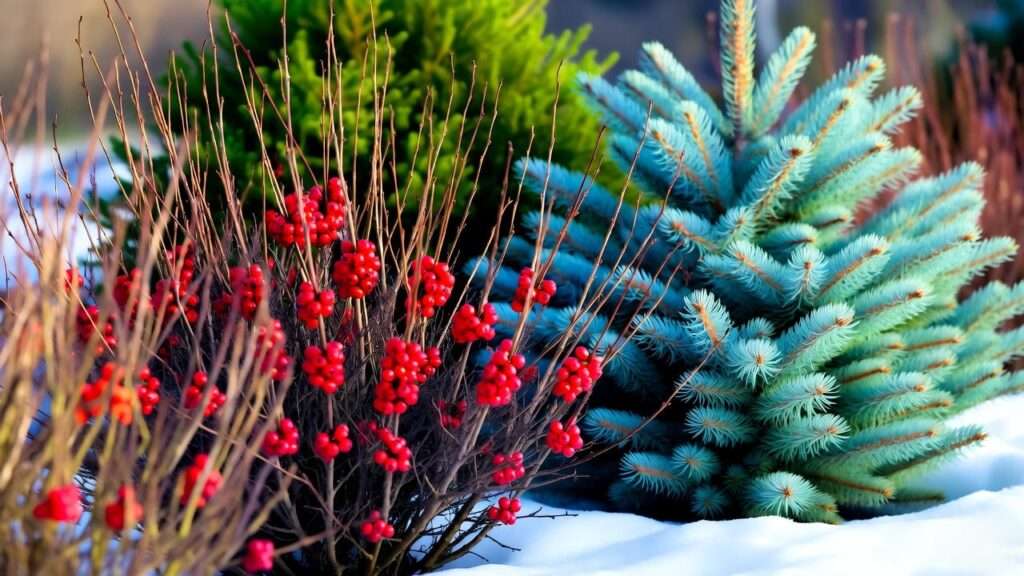Picture this: snow blankets your garden, the air is crisp, and yet your plants stand tall, vibrant, and resilient against the winter chill. For gardeners in cold climates, choosing a winterhard plant is the key to maintaining a lush, thriving garden year-round. Whether you’re battling frosty Zone 3 winters or navigating milder Zone 6 conditions, the right winterhard plant can transform your outdoor space into a beacon of life even in the harshest seasons. In this comprehensive guide, we’ll share seven expert-backed tips to help you select and care for winterhard plants that flourish in cold climates. Backed by decades of horticultural experience and practical insights, this article will empower you to create a winter-ready garden that’s both beautiful and sustainable. Let’s dive in! 🌿
What Makes a Plant Winterhard? 🌱
Winterhardiness is the ability of a plant to survive low temperatures, frost, snow, and harsh winds without significant damage. It’s what separates a thriving evergreen from a frostbitten failure. Understanding this concept is critical for gardeners aiming to cultivate a resilient landscape.
Defining Winterhardiness
A winterhard plant is rated by its ability to endure specific temperature ranges, as defined by the USDA Hardiness Zones. These zones, based on average annual minimum temperatures, range from Zone 1 (below -50°F/-45°C) to Zone 13 (above 60°F/15°C). For example, a plant rated for Zone 4 can withstand temperatures as low as -30°F (-34°C), making it ideal for cold climates. According to Dr. Laura Jull, a horticulture expert at the University of Wisconsin, “Winterhardiness isn’t just about surviving cold—it’s about thriving through freeze-thaw cycles, wind, and snow load.” Knowing your zone ensures you pick plants that can handle your region’s winters.
Characteristics of Winterhard Plants
Winterhard plants share traits that help them endure cold. Evergreens like junipers have thick, waxy needles that reduce water loss, while deciduous plants like Red Twig Dogwood shed leaves to conserve energy. Deep root systems anchor plants against wind and stabilize them in frozen soil. Some plants, like Winterberry Holly, produce colorful berries that add visual appeal while supporting wildlife. These adaptations make winterhard plants both functional and beautiful additions to your garden.
Tip 1: Understand Your Climate and Hardiness Zone 🗺️
Before planting, you need to know your local climate. The USDA Hardiness Zone map is your starting point for selecting winterhard plants that will thrive.
Matching Plants to Your Zone
To find your zone, visit the USDA’s interactive map or consult your local agricultural extension office. For example, Zone 3 gardeners (think Minnesota or Montana) need plants that tolerate -40°F (-40°C), like Siberian Iris or Serviceberry. Zone 6 gardeners (milder areas like parts of Oregon) can opt for plants like Rhododendrons. Below is a quick reference table for popular winterhard plants:
| Plant | Hardiness Zone | Care Needs |
|---|---|---|
| Winterberry Holly | 3–9 | Moist soil, full sun to part shade |
| Siberian Iris | 3–9 | Well-drained soil, full sun |
| Colorado Blue Spruce | 2–7 | Well-drained soil, full sun |
| Red Twig Dogwood | 3–8 | Moist soil, full sun to part shade |
Common Mistakes to Avoid
One common error is choosing a plant rated for a warmer zone, hoping it will “tough it out.” This rarely works and leads to plant loss. Another mistake is ignoring microclimates—small areas in your garden that are warmer or colder due to factors like shade or wind exposure. For borderline zones, enhance winterhardiness with mulch or windbreaks. Tip: Apply a 2–4-inch layer of mulch around the base of plants to insulate roots, but avoid piling it against the stem to prevent rot.
Tip 2: Select the Right Winterhard Plant for Your Garden 🌸
Choosing the right plant involves balancing aesthetics, function, and climate suitability. Here’s how to make an informed choice.
Evergreen vs. Deciduous Options
Evergreens like Colorado Blue Spruce provide year-round color and structure, making them ideal for privacy screens or focal points. Deciduous plants like Red Twig Dogwood offer seasonal drama, with vibrant red stems that pop against snow. Both have their place, but consider your garden’s needs. Want constant greenery? Go evergreen. Craving seasonal variety? Choose deciduous.
Native Plants for Cold Climates
Native winterhard plants, like Purple Coneflower or American Cranberrybush, are adapted to local conditions, requiring less water and maintenance. They also support pollinators and wildlife, boosting your garden’s ecological value. For example, Purple Coneflower thrives in Zones 3–8 and attracts birds with its seed heads in winter. “Native plants are a win-win,” says botanist Emily Carter. “They’re tough, sustainable, and blend seamlessly into the local ecosystem.”
Aesthetic and Functional Choices
Think about your garden’s purpose. For visual appeal, Winterberry Holly’s red berries create a stunning winter contrast. For function, a row of Arborvitae can serve as a windbreak. Visit a local nursery for region-specific recommendations, and always check plant tags for hardiness ratings.
Tip 3: Prepare Your Soil for Winter Success 🌍
Healthy soil is the foundation of a thriving winterhard plant. Cold climates can compact soil or deplete nutrients, so preparation is key.
Soil Testing and Amendments
Test your soil’s pH and nutrient levels using a kit from a garden center or your local extension service. Most winterhard plants prefer slightly acidic to neutral soil (pH 6.0–7.0). Amend poor soil with compost or aged manure to improve drainage and fertility. For example, adding organic matter to clay-heavy soil prevents waterlogging, which can freeze and damage roots.
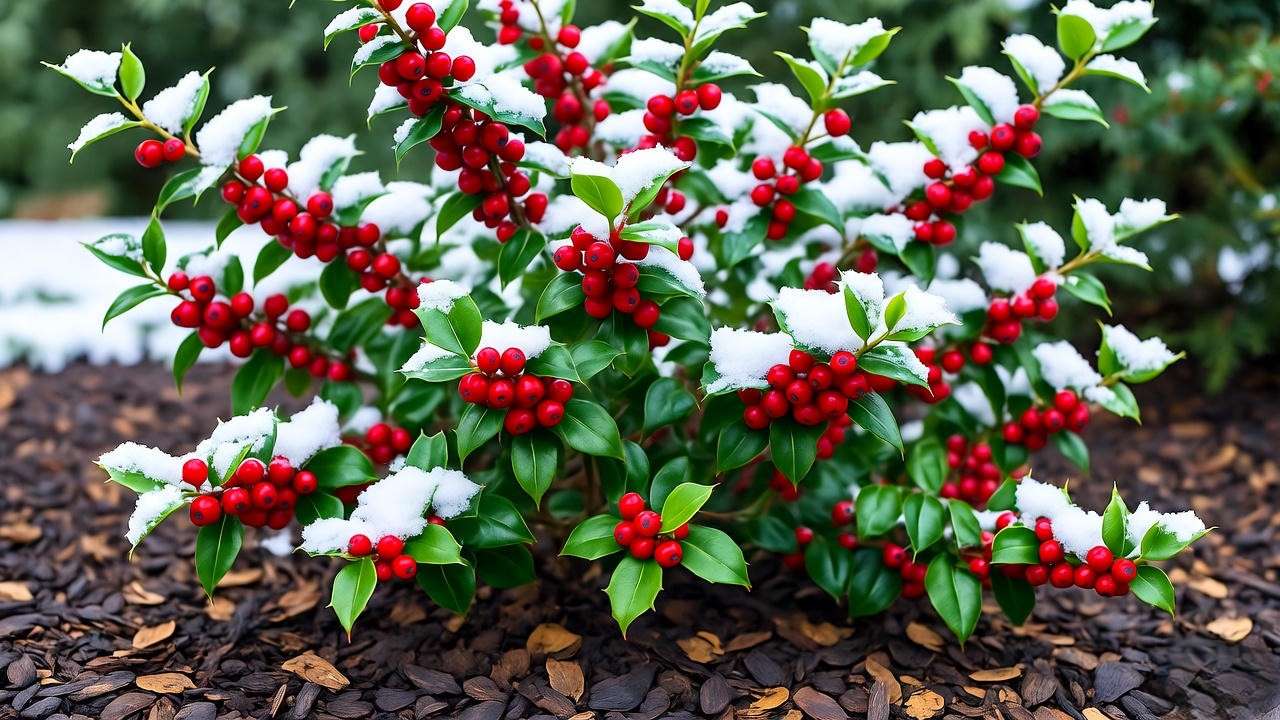
Mulching for Winter Protection
Mulch is a winterhard plant’s best friend. A 2–4-inch layer of bark chips, straw, or shredded leaves insulates roots, regulates soil temperature, and retains moisture. Apply mulch after planting, keeping it 1–2 inches away from the plant’s base to avoid rot. In early winter, check mulch levels and replenish if needed. Pro tip: Use pine needles for acid-loving plants like Rhododendrons.
Tip 4: Proper Planting Techniques for Cold Climates 🌱
Planting correctly sets your winterhard plant up for long-term success. Timing and technique are critical in cold climates.
Best Time to Plant
Fall (late August to early October) is ideal for planting winterhard plants, as cooler temperatures allow roots to establish before winter. Early spring is another good option, especially for perennials. Avoid late fall planting, as young plants may not survive sudden freezes.
Planting Steps for Success
Follow these steps for optimal planting:
- Dig a wide hole: Make it twice the width of the root ball but no deeper.
- Loosen soil: Break up compacted soil to encourage root growth.
- Position the plant: Ensure the root crown is level with the soil surface.
- Backfill and water: Fill the hole with soil, tamp gently, and water thoroughly.
A diagram showing proper planting depth can help visualize this process. For example, planting too deep can suffocate roots, while planting too shallow exposes them to frost.

Protecting Young Plants
Young winterhard plants are vulnerable to wind and frost. Wrap shrubs in burlap or use tree guards for saplings to shield against harsh weather. Water plants deeply before the ground freezes to ensure they’re hydrated through winter.
Tip 5: Watering and Feeding Winterhard Plants in Cold Seasons 💧
Proper hydration and nutrition are vital for winterhard plants, even during the dormant months. Cold climates can dry out plants through wind and freeze-thaw cycles, so strategic care ensures they stay healthy.
Winter Watering Needs
While winterhard plants require less water in winter, they still need moisture, especially evergreens, which lose water through their needles or leaves. Water deeply during dry spells when temperatures are above freezing, typically every 2–3 weeks if there’s no significant rain or snowmelt. “Evergreens can suffer from winter desiccation,” notes Dr. Michael Dirr, a renowned horticulturist. “Watering before a deep freeze is critical to prevent needle burn.” Focus on the root zone, using a slow trickle to ensure deep penetration without runoff. Avoid overwatering, as soggy soil can lead to root rot, particularly in poorly drained areas.
Fertilizing Do’s and Don’ts
Fertilizing winterhard plants requires caution. Avoid feeding in late summer or fall, as this can stimulate new growth that’s vulnerable to frost damage. Instead, apply a slow-release, balanced fertilizer (e.g., 10-10-10) in early spring to support healthy growth as plants emerge from dormancy. For example, Rhododendrons and Azaleas benefit from fertilizers formulated for acid-loving plants. Always follow package instructions and avoid over-fertilizing, which can burn roots or disrupt soil balance. Tip: Test soil nutrient levels annually to tailor your fertilizing plan.
Tip 6: Protect Your Plants from Winter Damage ❄️
Winter brings unique challenges like frost, snow, ice, and hungry animals. Protecting your winterhard plants ensures they emerge healthy in spring.
Guarding Against Frost and Snow
Frost can damage tender growth, while heavy snow can break branches. For evergreens, apply an anti-desiccant spray (available at garden centers) in late fall to reduce water loss from needles or leaves. For shrubs and small trees, gently brush off accumulated snow with a broom to prevent breakage. Avoid shaking branches, as this can cause cracks in frozen wood. For delicate plants like young Boxwoods, consider wrapping them in breathable burlap to shield against frost and windburn.
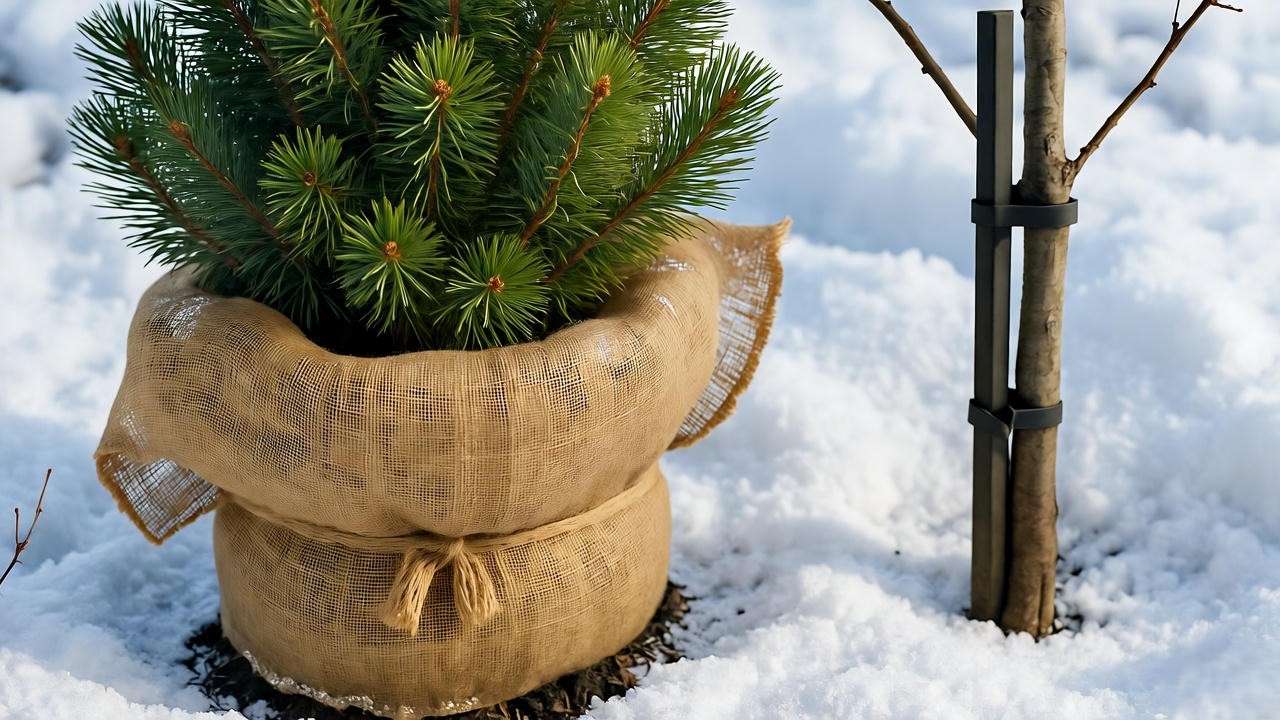
Preventing Animal Damage
In winter, deer, rabbits, and rodents often target winterhard plants for food. Deer may strip foliage, while rabbits and voles chew bark, especially on young trees. Install physical barriers like chicken wire or plastic tree guards around trunks to deter chewing. For deer, use repellents with natural ingredients like garlic or capsaicin, reapplying after heavy rain or snow. A case study from a Minnesota gardener showed that wrapping young Red Osier Dogwoods in burlap reduced deer damage by 90%. Tip: Check barriers regularly to ensure they remain secure.
Wind and Ice Protection
Strong winter winds can dry out plants or topple young trees. Stake saplings with flexible ties to provide support without restricting growth. For evergreens, erect windbreaks using burlap screens or wooden panels placed on the windward side. Ice storms pose another threat, as heavy ice can snap branches. If ice buildup occurs, avoid removing it manually; instead, let it melt naturally to prevent damage. To prevent sunscald (bark cracking due to rapid temperature changes), wrap tree trunks with light-colored burlap or tree wrap in late fall.
Tip 7: Pruning and Maintenance for Long-Term Health ✂️
Regular pruning and maintenance keep winterhard plants healthy, shapely, and resilient. Timing and technique are critical to avoid stressing plants.
When and How to Prune
The best time to prune most winterhard plants is late winter or early spring, before new growth begins. This minimizes stress and allows plants to heal quickly. For example, prune deciduous shrubs like Red Twig Dogwood in March to encourage vibrant new stems. Use sharp, clean pruning shears to make angled cuts just above a bud. Remove dead, damaged, or crossing branches to improve air circulation and reduce disease risk. For evergreens like Junipers, light trimming in early spring maintains shape without removing too much foliage. Avoid heavy pruning in fall, as it can weaken plants before winter.
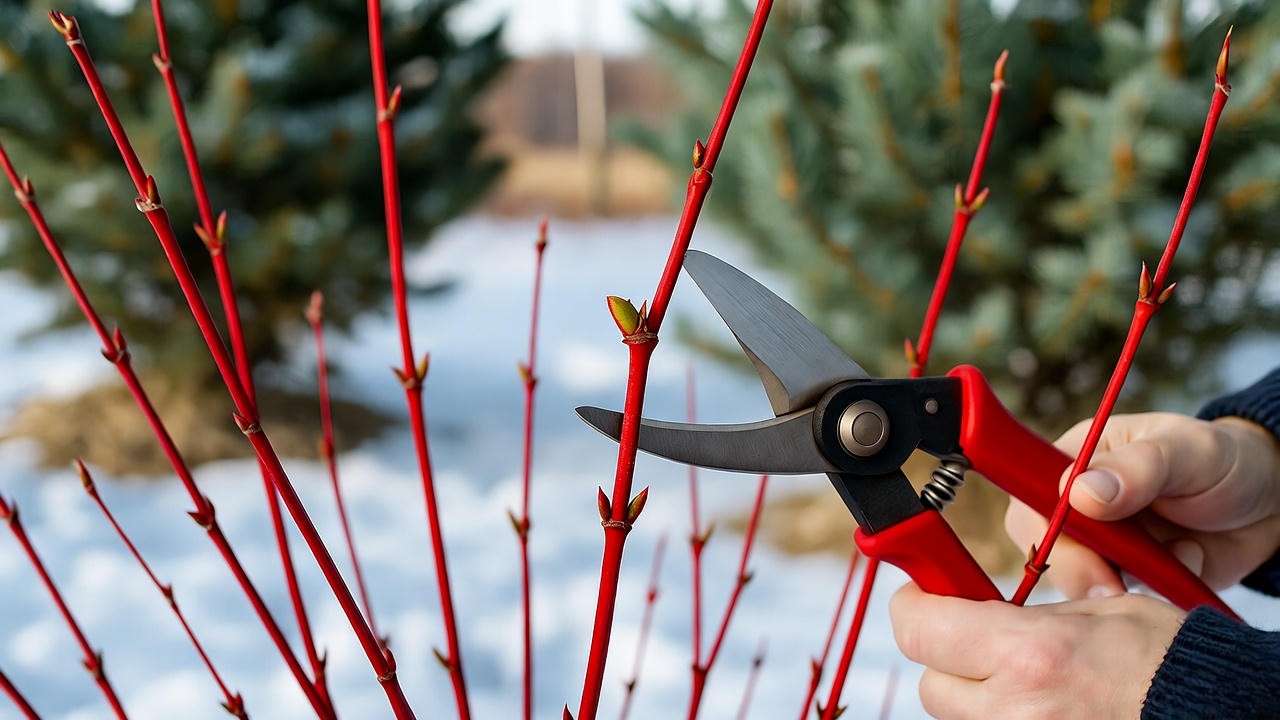
Ongoing Care Tips
Regular maintenance extends the life of winterhard plants. Inspect plants monthly for signs of pests, disease, or winter damage, such as browning needles or cracked bark. Remove debris like fallen leaves to prevent fungal growth. In spring, check for heaving (roots pushed up by freeze-thaw cycles) and gently press soil back around roots. Create a seasonal care checklist:
- Fall: Mulch, water deeply, apply anti-desiccant spray.
- Winter: Monitor for snow or ice damage, check barriers.
- Spring: Fertilize, prune, inspect for pests.
- Summer: Maintain consistent watering, weed around plants.
Reviving Stressed Plants
If a winterhard plant shows signs of stress (e.g., yellowing leaves or sparse growth), act quickly. For evergreens with browning needles, trim affected areas and ensure adequate water. For trees with cracked bark, consult an arborist, as this may indicate severe damage. Fertilize lightly with a balanced product and monitor recovery over the growing season. “Patience is key,” says arborist John Smith. “Many winterhard plants can bounce back with proper care.”
Top Winterhard Plants to Consider for Your Garden 🌲
Here’s a curated list of seven winterhard plants that thrive in cold climates, offering beauty and resilience.
- Winterberry Holly (Ilex verticillata) – Zones 3–9
- Bright red berries add winter color; thrives in moist soil and full sun to part shade.
- Care Tip: Plant male and female shrubs for berry production.
- Siberian Iris (Iris sibirica) – Zones 3–9
- Elegant purple blooms and grass-like foliage; prefers well-drained soil and full sun.
- Care Tip: Divide clumps every 3–4 years to maintain vigor.
- Colorado Blue Spruce (Picea pungens) – Zones 2–7
- Striking blue needles and conical shape; ideal as a focal point or windbreak.
- Care Tip: Ensure well-drained soil to prevent root rot.
- Red Twig Dogwood (Cornus sericea) – Zones 3–8
- Vibrant red stems glow against snow; tolerates wet soil and partial shade.
- Care Tip: Prune older stems to encourage new growth.
- Purple Coneflower (Echinacea purpurea) – Zones 3–8
- Pink-purple flowers attract pollinators; seed heads feed birds in winter.
- Care Tip: Deadhead spent blooms to extend flowering.
- Arborvitae (Thuja occidentalis) – Zones 2–7
- Dense evergreen foliage for privacy; adapts to various soils.
- Care Tip: Water regularly in the first year to establish roots.
- Hellebore (Helleborus spp.) – Zones 4–9
- Early-blooming flowers in shades of white, pink, or purple; thrives in shade.
- Care Tip: Mulch to protect shallow roots.
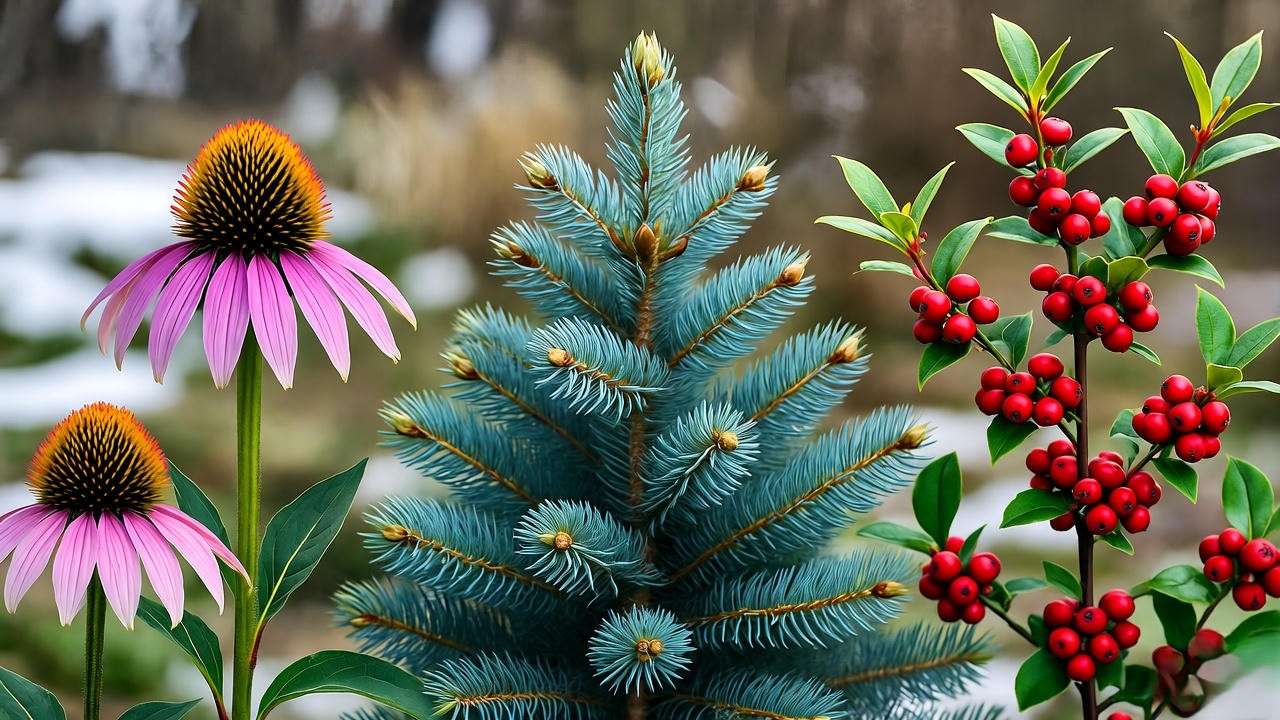
Why These Plants Stand Out
These plants offer unique features like colorful berries, striking foliage, or wildlife benefits. For example, Winterberry Holly’s berries feed birds, while Arborvitae’s dense growth creates a natural privacy screen. Below is a quick reference table:
| Plant | Light Needs | Water Needs | Soil Type |
|---|---|---|---|
| Winterberry Holly | Full sun/part shade | Moist | Loamy, well-drained |
| Siberian Iris | Full sun | Moderate | Well-drained |
| Colorado Blue Spruce | Full sun | Low | Well-drained |
| Red Twig Dogwood | Full sun/part shade | Moist | Adaptable |
Where to Buy Quality Plants
Purchase from reputable sources like local nurseries or online retailers such as Monrovia or Proven Winners. Look for plants labeled with their hardiness zone and grown in conditions similar to your region. Tip: Ask for certified disease-free stock to ensure healthy plants.
Common Winterhard Plant FAQs ❓
Here are answers to common questions about winterhard plants, based on search intent:
- Can winterhard plants grow in pots?
Yes, but choose large, insulated containers and use well-draining potting mix. Protect pots from freezing by wrapping them in bubble wrap or moving them to a sheltered area. - What’s the most cold-tolerant winterhard plant for Zone 3?
Colorado Blue Spruce and Siberian Iris are excellent choices, surviving down to -40°F (-40°C). - How do I protect my winterhard plant from heavy snow?
Gently brush snow off branches and use burlap wraps for delicate shrubs. - Do winterhard plants need watering in winter?
Yes, water evergreens during dry spells when temperatures are above freezing. - Can I plant winterhard plants in spring?
Early spring is ideal, as it allows roots to establish before summer heat. - How do I know if my plant is winterhard?
Check the plant tag for its USDA Hardiness Zone rating and compare it to your local zone.
Conclusion 🌿
Creating a thriving winter garden starts with choosing and caring for the right winterhard plants. By understanding your hardiness zone, selecting climate-appropriate species, preparing soil, planting correctly, watering wisely, protecting against damage, and maintaining regularly, you can enjoy a vibrant landscape even in the coldest months. Start small with native plants like Purple Coneflower or Red Twig Dogwood, and experiment with evergreens for year-round beauty. Share your winter gardening successes in the comments below, and explore related articles on our site, such as “Best Companion Plants for Winterhard Shrubs” or “Designing a Winter Garden.” Happy gardening! 🌲

